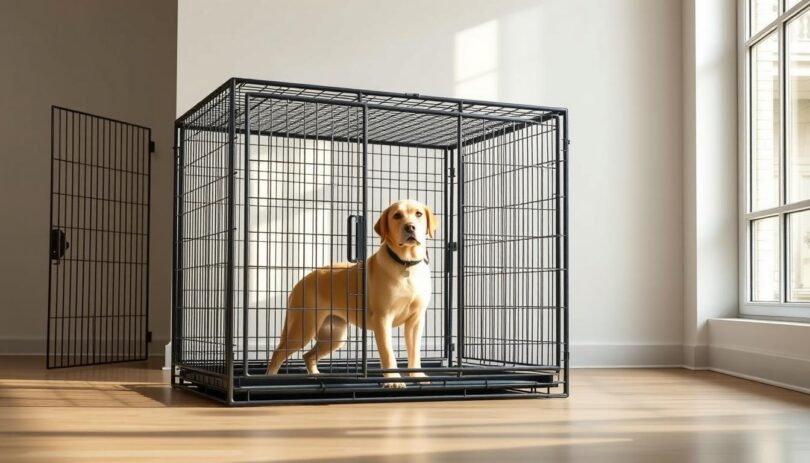Did you know 65% of dog owners use crates daily? A secure, well-designed space isn’t just about confinement—it’s a sanctuary that reduces anxiety and supports training. Choosing the right crate ensures your pet’s safety while blending seamlessly into your lifestyle.
High-quality options prioritize features like knurled bolts for reinforced joints and molded corners to safely stack multiple units. Take the K9 Kennel Boss, praised by users for its auto-engaging slam latch and built-in handles. One owner noted, “The door locks instantly, and the handles make moving it effortless.”
Look for crates designed for pets up to 35” tall, with external dimensions around 48”L x 31”W x 35”H. Collapsible frames save space when not in use, while heavy-duty construction withstands energetic behavior. Easy assembly—often under 10 minutes—means less hassle during setup.
This guide explores crates balancing security, portability, and comfort. You’ll discover how innovative designs simplify cleaning, travel, and long-term use. Let’s dive into expert-vetted picks that prioritize your pet’s well-being without compromising practicality.
Understanding Big Dog Cages: Features and Benefits
Pet owners often overlook critical design elements when selecting a secure space for their furry friends. The right enclosure combines industrial-strength materials with thoughtful engineering to create a stress-free environment. Let’s explore what makes these products effective for both training and daily use.
Built to Last: Materials That Matter
High-quality options use powder-coated steel frames and reinforced joints to withstand energetic behavior. Molded corners prevent sharp edges, while slide-bolt latches ensure doors stay closed during anxious moments. For breeds like German Shepherds, look for units measuring at least 48”L x 31”W – enough space to sit, stand, and turn around comfortably.
Practical Advantages for Busy Households
Non-toxic plastic trays simplify cleanup after muddy adventures, and removable panels allow thorough disinfecting. These features prove invaluable when transitioning pets between indoor spaces and best outdoor dog kennel setups. Secure latching systems give peace of mind, especially for escape-prone animals requiring extra supervision.
Proper sizing remains crucial – measure from nose base to tail base, then add 4 inches. This ensures your companion’s long-term comfort while maintaining the enclosure’s structural integrity through years of use.
Expert Roundup: Top-Rated Big Dog Cages on the Market
Professional trainers and seasoned owners agree: The right enclosure transforms training outcomes and daily routines. We’ve analyzed hundreds of verified reviews and industry benchmarks to spotlight standout products that deliver results.
K9 Kennel Boss – A High-Anxiety Solution
This collapsible crate shines for pets with separation stress. Its 48″L x 31″W frame features dual-access doors with slam-latch mechanisms. One Labrador owner shared: “After three escape attempts, the auto-locking system kept our anxious rescue secure during thunderstorms.”
Veterinarians praise its rounded corners and rust-resistant coating. Foldable panels make storage effortless, while the 24-gauge steel withstands 120+ lbs of force. Ideal for travel, it disassembles in 90 seconds without tools.
Midwest Options – Sturdiness for Giant Breeds
Built for Mastiffs and Great Danes, Midwest’s double-door design includes a divider panel for adjustable sizing. The 52″ model supports 180 lbs, with reinforced seams at stress points. A German Shepherd breeder noted: “The slide-bolt latches prevent Houdini acts – even our smartest pup stays put.”
Its epoxy-coated wire resists chewing, while the removable plastic tray simplifies cleanup. Unlike flimsier options, the cross-bracing keeps the structure rigid during energetic moments. Assembly takes under 15 minutes, requiring no specialized tools.
Evaluating Size, Strength, and Security in Dog Crates
Finding the right balance between space and security starts with precise measurements. A crate that’s too small restricts movement, while one that’s oversized undermines safety. Start by measuring your pet from nose base to tail base, then add 4 inches for comfort. Don’t forget to check your home’s layout – ensure the unit fits your room without blocking walkways.
Measuring for the Perfect Fit in Your Home
Most brands list external dimensions like 42”L x 28”W – compare these to your available floor space. For breeds needing room to turn around, opt for models with internal heights matching your pet’s standing ear tips. Test placements near walls or furniture using painter’s tape outlines. This visual guide prevents surprises during setup.
Safety Features and Reliable Latches
Slide-bolt latches outperform basic hooks, especially for determined escape artists. Reinforced corners with drop-pins prevent collapse, while chew-resistant wire maintains structural integrity. The Diggs Revol crate showcases this with its dual-locking doors and rounded edges. Pair these features with effective puppy training techniques for stress-free containment.
Look for crates using 12-gauge steel frames and non-toxic plastic trays. These materials withstand daily use while keeping pets safe. Always verify weight limits – a 90 lb Labrador needs a unit rated for 120+ lbs. Proper sizing and construction create a secure retreat your companion actually enjoys using.
Comparing Key Options: Dog Crate Construction & Price
Balancing affordability with unshakable durability is the ultimate challenge when choosing pet enclosures. Premium models often cost more upfront but save money over years of use. Let’s break down how material choices and add-ons impact both immediate budgets and long-term value.
Material Durability and Industrial Strength
Heavy-duty crates like the Midwest 54” model use 12-gauge steel frames—thicker than budget options’ 16-gauge metal. Reinforced corners with drop-pin locks prevent collapse, even when 150-pound breeds lean against doors. ABS plastic pans resist scratches and odors better than standard trays, reducing replacement costs.
Industrial powder coating adds rust protection for outdoor use. Brands like Impact Dog Crates weld joints instead of using bolts, eliminating weak points. These features justify higher prices by extending product lifespans 3-5 years beyond cheaper alternatives.
Cost, Value, and Long-Term Investment
A $300 crate with divider panels adapts as puppies grow, avoiding multiple purchases. Quiet-time pet beds ($40-$60 add-ons) reduce anxiety-related damage, protecting crate interiors. Compare this to replacing a $120 unit every 18 months due to bent wires or broken latches.
Secure assembly systems matter too. Models with dual slide-bolt latches cost 15% more but prevent escapes requiring costly repairs. For large breeds, investing in chew-resistant doors and reinforced corners pays off through decades of daily use without structural failures.
Tips for Seamless Assembly and Easy Cleaning
Proper setup and maintenance keep your pet’s space secure and hygienic. Follow these tested methods to ensure hassle-free assembly and lasting freshness.
Step-by-Step Assembly Guidance
Start by laying out all parts on a flat surface. Connect side panels using knurled bolts at each corner—hand-tighten first, then use a wrench for final security. Check that doors swing freely before locking latches. For collapsible models, test folding mechanisms twice to confirm smooth operation.
Download manufacturer guides for torque specifications if available. Many brands offer video tutorials showing how to reinforce stress points. One owner shared: “Double-checking bolt alignment prevented wobbling issues with our 48-inch unit.”
Cleaning Best Practices for Longevity
Remove plastic trays weekly for deep cleaning. Use mild soap and warm water to scrub wire surfaces, focusing on corners where odors linger. Avoid abrasive pads that scratch coatings. For stubborn stains, mix baking soda and vinegar—let sit 10 minutes before rinsing.
Air-dry all components completely to prevent rust. Replace chew pads at the bottom every 3-6 months. Store collapsible crates in dry areas to maintain structural integrity. These steps protect your investment while keeping your companion’s environment sanitary.
Final Thoughts on Selecting the Right Big Dog Cages for Your Home
Choosing the ideal crate hinges on four pillars: strength, safety, space, and smart budgeting. Products like the K9 Kennel Boss demonstrate how innovative designs—think auto-locking doors and rust-resistant coatings—address anxiety while lasting years. Similarly, Midwest’s reinforced seams and divider panels show how adaptable solutions grow with your pet.
Measurements matter most. Always verify your companion’s nose-to-tail base length before selecting sizes. Two-door crates simplify access, while collapsible frames save room in compact homes. Reviews consistently praise these features for balancing security with daily convenience.
Prioritize steel frames and chew-proof latches over temporary savings. Though pricier upfront, heavy-duty options reduce long-term costs by avoiding replacements. Let this guide’s insights on materials, assembly, and cleaning ease steer your decision.
Your pet’s comfort and safety deserve thoughtful investment. With the right crate—one matching their needs and your lifestyle—you’ll create a trusted retreat they’ll happily use for years.
FAQ
What features make a crate structurally sound for large breeds?
Look for reinforced steel frames, thick gauge wire, and industrial-strength latches. Brands like Midwest and K9 Kennel Boss use welded construction for stability. Double-door designs add accessibility without compromising security.
How do I choose between collapsible vs. permanent crate options?
Collapsible crates like Frisco’s Fold & Carry work for travel or temporary use, while heavy-duty kennels with bolt-together panels (e.g., ProSelect Empire) suit long-term needs. Consider your pet’s behavior—anxious chewers need fixed structures.
Are plastic crates safe for German Shepherds or similar-sized dogs?
Hard-shell plastic crates (like Petmate Sky Kennel) work for short-term containment but lack ventilation for extended use. Wire crates with removable trays better accommodate active large breeds needing airflow and visibility.










Leave a Comment